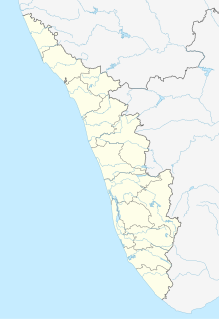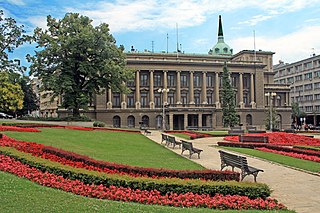
The Raj Bhavan, formerly known during British India as the Bangalore Residency, the Mysore State Residency, or, simply, the Residency, is the official residence of the Governor of Karnataka. It is located in the capital city of Bangalore, Karnataka. During Mysore Kingdom, the building was home to the Resident of the British Agency that was in subsidiary alliance with the Kingdom of Mysore.

Padmanabhapuram Palace is a Travancore era palace located in Padmanabhapuram, Kalkulam taluk of Kanyakumari District, Tamil Nadu. It is also known as Kalkulam Palace.

Raj Bhavan is the official residence of the Governor of West Bengal, located in the capital city Kolkata. Built in 1803, it was known as Government House before the independence of India.

Bolgatty Palace is a former palace built by the Dutch in India on Bolgatty Island in Kochi, Kerala. One of the oldest existing Dutch palaces outside Holland, this quaint mansion was built in 1744 by Dutch traders and later extended and gardens were landscaped around it. The building was then the Governor's palace for the commander of Dutch Malabar, and in 1909 was leased to the British. It served as the home of the British governors, being the seat of the British Resident of Cochin during the British Raj.
The Raj Bhavan at Darjeeling is the Summer residence for the Governor of West Bengal, It is located in the city of Darjeeling, West Bengal.

The Kerala Tourism Development Corporation (KTDC) is a public sector undertaking that conducts and regulates the tourism activities in the Indian state of Kerala. The KTDC is headquartered at Thiruvananthapuram and has offices across all the districts of Kerala. The agency also operates hotels, resorts, and tourist rest houses in key locations in the state. Its official slogan is "Official host to God's own country." It is one of the most profitable ventures of the Kerala government.
Raj Bhavan is the official residence of the Governor of Arunachal Pradesh. It is located in the capital city of Itanagar, Arunachal Pradesh. The present Governor of Arunachal Pradesh is Padmanabha Acharya.
Raj Bhavan is the official winter residence of the Governor of Jammu and Kashmir. It is located in the Winter capital city Jammu, Jammu and Kashmir.
Raj Bhavan is the official residence of the Governor of Tripura. It is located in the capital city of Agartala, Tripura. A new Raj Bhavan was built and inaugurated in April 2018. The previous Raj Bhavan was built in 1917, it was known as the Pushbanta Palace in the pre-independence days. It will become a museum and research centre on Maharaja Birendra Kishore Manikya Debbarman Bahadur. The present governor of Tripura is Kaptan Singh Solanki.
Raj Bhavan of Ooty is the Summer residence of the Governor of Tamil Nadu, It is located in the city of Ooty, Tamil Nadu.

Tourism in Thiruvananthapuram (Trivandrum) district in the Indian state of Kerala promotes the area's hill stations, back waters, beaches, lagoons, and wildlife sanctuaries. The area is a tourism destination and receives chartered flights for medical tourism, as there are more than hundred recognised Ayurveda centres in and around the city. This is primarily due to Ayurveda's popularity in foreign countries. Medical tourism is further promoted by modern medicine hospitals in the city. Recuperation facilities are available at five star beach resorts and hill stations nearby.
Vellayambalam is a prominent junction in the city of Thiruvananthapuram in the state of Kerala, India. It is situated on the Rajapatha that stretches from Kowdiar to East Fort.

Pattom is a part of the Thiruvananthapuram city of Kerala. It is located approximately 4 kilometres north of centre of Thiruvananthapuram. Pattom is largely a residential area, also housing few important administration offices of Kerala State and a few shopping complexes. It has offices of Kerala Public Service Commission, Kerala State Planning Board, Life Insurance Corporation of India, Thiruvananthapuram Divisional Office, LIC Housing Finance Limited, State Resource Centre, District Panjayat Headquarters, Fire and Rescue Department Headquarters, Kerala Co-operative Milk Marketing Federation (Milma), Employees Provident Fund Regional Office and Kerala State Electricity Board. The Traffic Police and Telecommunication department, and the Kerala Science, Technology and Environment Head Office are also located in Pattom.

Kerala House is the official state mission of Government of Kerala at New Delhi. As each state of India has to maintain a statutory representative and state mission house in the capital, to liaison with Central Government on behalf of state.

Cliff House is the official residence of the Chief Minister of Kerala, located at Nanthancode in the state capital Thiruvananthapuram. The Cliff House is part of Cliff House compound, which houses four other ministerial residences and is located within the state ministerial residential zone.

The Niyamasabha Mandiram, located in Palayam, Thiruvananthapuram, is the seat of the Kerala State Legislative Assembly or the Niyamasabha. Built primarily in the classical style of Architecture of Kerala, with strong influences of many contemporary styles, it is a structure with grand staircase, gardens, water bodies and a large Central Assembly Hall. Located in a high security zone, the complex accommodates the residence of the Speaker of the Niyamasabha, legislature offices of all MLAs and offices of independent commissions and bodies. The assembly was opened on 22 May 1998, by the President of India, K. R. Narayanan.
Raj Bhavan is the official residence of the Governor of Tripura. The incumbent Governor of Tripura is Hon'ble Shri Tathagata Roy. The residence is located in the state's capital city of Agartala. A new Raj Bhavan was built and inaugurated in April 2018. The previous Raj Bhavan was built in 1917, and was known as the Pushbanta Palace prior to India's independence. The previous Raj Bhavan edifice is intended to become a museum and research center in honor of King of Tripura, Maharaja Birendra Kishore Manikya.

















